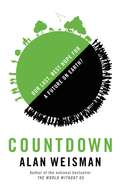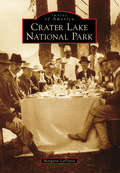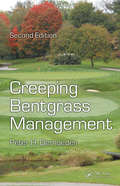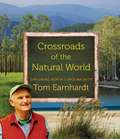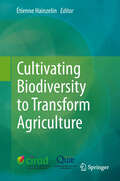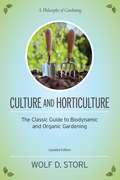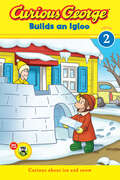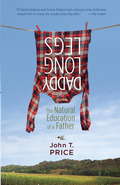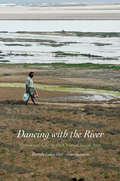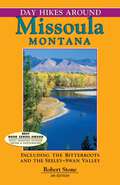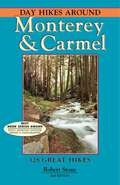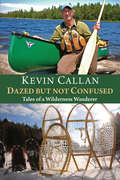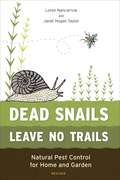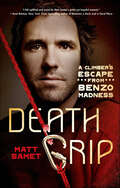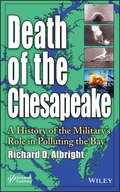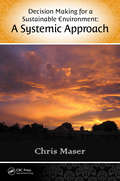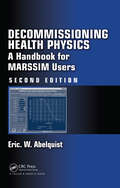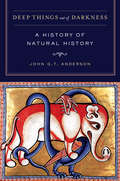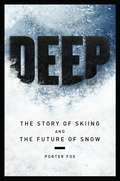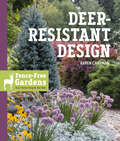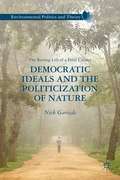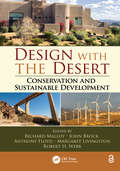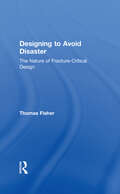- Table View
- List View
Countdown: Our Last, Best Hope for a Future on Earth?
by Alan WeismanA powerful investigation into the chances for humanity's future from the author of the bestseller The World Without Us.In his bestselling book The World Without Us, Alan Weisman considered how the Earth could heal and even refill empty niches if relieved of humanity's constant pressures. Behind that groundbreaking thought experiment was his hope that we would be inspired to find a way to add humans back to this vision of a restored, healthy planet-only in harmony, not mortal combat, with the rest of nature.But with a million more of us every 4¿ days on a planet that's not getting any bigger, and with our exhaust overheating the atmosphere and altering the chemistry of the oceans, prospects for a sustainable human future seem ever more in doubt. For this long awaited follow-up book, Weisman traveled to more than 20 countries to ask what experts agreed were probably the most important questions on Earth--and also the hardest: How many humans can the planet hold without capsizing? How robust must the Earth's ecosystem be to assure our continued existence? Can we know which other species are essential to our survival? And, how might we actually arrive at a stable, optimum population, and design an economy to allow genuine prosperity without endless growth?Weisman visits an extraordinary range of the world's cultures, religions, nationalities, tribes, and political systems to learn what in their beliefs, histories, liturgies, or current circumstances might suggest that sometimes it's in their own best interest to limit their growth. The result is a landmark work of reporting: devastating, urgent, and, ultimately, deeply hopeful.By vividly detailing the burgeoning effects of our cumulative presence, Countdown reveals what may be the fastest, most acceptable, practical, and affordable way of returning our planet and our presence on it to balance. Weisman again shows that he is one of the most provocative journalists at work today, with a book whose message is so compelling that it will change how we see our lives and our destiny.
Crater Lake National Park
by Margaret LaplanteFor more than half a million years, volcano Mount Mazama towered over southern Oregon. From time to time, it erupted, spreading pumice, ash, and cinders for miles around. Then, approximately 7,700 years ago, Mount Mazama erupted with such force that the volcano could no longer support itself and it collapsed, leaving a large caldera. Eventually, the volcanic action subsided and all was calm. Over the next centuries, water and snow accumulated in the caldera. In 1902, Crater Lake became a national park.
Creeping Bentgrass Management
by Peter H. DernoedenCreeping bentgrass is considered the premier turfgrass species grown on golf courses, and there is a growing demand for an understanding of its maintenance and management practices. Still the only comprehensive reference on the subject, Creeping Bentgrass Management, Second Edition helps you identify the factors that contribute to summer bentgrass
Crossroads of the Natural World
by Tom EarnhardtIn this richly illustrated love letter to the wild places and natural wonders of North Carolina, Tom Earnhardt, writer and host of UNC-TV's Exploring North Carolina and lifelong conservationist, seamlessly ties deep geological time and forgotten species from our distant past to the unparalleled biodiversity of today. With varied topography and a climate that is simultaneously subtropical, temperate, and subarctic, he shows that North Carolina is a meeting place for living things more commonly found far to the north and south. Highlighting the ways in which the state is a unique ecological crossroads, Earnhardt's research, insightful writing, and stunning photography will both teach and inspire. Crossroads of the Natural World invites readers to engage a variety of topics, including the impacts of invasive species, the importance of forested buffers along our rivers, the role of naturalists, and the challenges facing the state in a time of climate change and sea-level rise. By sharing his own journey of more than sixty years, Earnhardt entices North Carolinians of every age to explore the natural diversity of our state.
Cuerpos de plantas increíbles de diminutos a gigantescos (¡Arriba la Lectura!, Big Book Module 9 #3)
by Ellen Lawrence Suzy Gazlay Robin KimmererNIMAC-sourced textbook
Cultivating Biodiversity to Transform Agriculture
by Étienne HainzelinHow can cultivated plant biodiversity contribute to the transformation and the "ecologization" of agriculture in Southern countries? Based on extensive field work in the Southern countries, a great deal of scientific progress is presented in all areas affecting agriculture (agronomy, plant breeding and crop protection, cultivation systems, etc. ) in order to intensify the ecological processes in cultivated plots and at the scale of rural landscapes.
Culture and Horticulture: The Classic Guide to Biodynamic and Organic Gardening
by Wolf D. Storl Larry BergerVarious studies have shown time and again that small organic farms and home gardens are capable of producing more food per acre with less fossil energy than large-scale commercial agricultural installations dependent on machines and toxic chemical fertilizers and pesticides. This classic book by Wolf D. Storl, a respected elder in the practice of permaculture, details how food is grown holistically and beautifully by traditional communities around the world, and shows how to apply their ancient wisdom to our own gardens.With interest in natural, sustainable, organic and local food at an all-time high, people are looking beyond their farmers markets and CSA cooperatives to hyperlocal ways of growing healthy, delicious produce in urban gardens and their own backyards. Culture and Horticulture details time-tested methods that are as effective today as they were hundreds of years ago. On the practical front, the book works as a manual for creating and maintaining a bountiful harvest. It explains how to build the soil to maintain fertility; how to produce compost; how to plant, sow, and tend the various fruit and vegetable plants; how to rotate crops and practice companion planting; how to set up a favorable microclimate; how to deal with so-called weeds and pests; how to harvest at the right time; and finally how to store vegetables and herbs. Special emphasis is given to the art and science of composting, the compost being the "heart" of any self-sufficient garden and a model for the cycle of life, death, and rebirth.At the same time the reader is introduced to the wider aspects of horticulture, to its historical, philosophical, and cosmological contexts and social relevance. Gardening is a cultural activity, shaped by peoples' thoughts, wishes, and needs as well as by their cultural traditions. The author, an anthropologist by profession who has investigated the gardening practices of indigenous people throughout the world and worked for many years on biodynamic farms and in his own food garden, will introduce the reader to Rudolf Steiner's vision of the garden as an organic unit, embedded in the context of terrestrial and cosmic forces. Storl explains the importance of cosmic rhythms (solar, lunar, and planetary), the role of biodynamic herbal preparations as "medicines" for the garden organism, and the so-called "etheric" and "astral" forces. The book presents a vision of the garden as seen through the eyes of "Goethean science," a magical place where alchemical transformations of material substances take place.
Curious George Builds an Igloo (CGTV Reader)
by H.A. ReyCurious George wishes for a snowy home that fits all his friends! But can a small monkey make his big dreams come true? In this snowy adventure based on the Emmy Award–winning PBS TV show, Curious George can&’t wait to help his friend Bill build an igloo and sleep in it overnight. But George thinks Bill&’s igloo is too small. He decides to build his own supersized igloo—big enough for a party! Will such a big igloo be too cold for a little monkey? This fun-filled Level 2 Green Light Reader includes an activity that helps kids identify things that melt as well as instructions for making their own mini-igloo out of sugar cubes and icing. For more monkey fun, check out www.curiousgeorge.com and discover all the latest books, promotions, games, activities, and more!
Daddy Long Legs: The Natural Education of a Father
by John PriceJohn Price appears to have thrown in the towel. He has spent the last year struggling to support his family, neglecting to spend time with his wife and children, and becoming increasingly cynical about the degraded state of the natural world around him. After a heart-attack scare, however, his wife demands that he start appreciating all the "good things" in his life: their mouse-infested old house, their hopelessly overgrown yard, and most of all, the joys and humiliations of parenthood. In his quest to become a better father, Price faces many unexpected challenges--like understanding his grandmother's decision to die, and supporting his nature-loving sons' decision to make their home a "no-kill zone" for all living creatures. Still he finds the second chance he was looking for--to save himself and, perhaps, his small corner of an imperfect yet still beautiful world.
Dancing with the River
by Kuntala Lahiri-Dutt Gopa SamantaWith this book Kuntala Lahiri-Dutt and Gopa Samanta offer an intimate glimpse into the microcosmic world of "hybrid landscapes." Focusing on chars--the part-land, part-water, low-lying sandy masses that exist within the riverbeds in the floodplains of lower Bengal--the authors show how, both as real-life examples and as metaphors, chars straddle the conventional categories of land and water, and how people who live on them fluctuate between legitimacy and illegitimacy. The result, a study of human habitation in the nebulous space between land and water, charts a new way of thinking about land, people, and people's ways of life.
Day Hikes Around Missoula, Montana: Including The Bitterroots And The Seeley-Swan Valley
by Robert StoneMissoula, Montana is an active university town rich in character set in the midst of stunning scenery. The city lies at the hub of five merging valleys and surrounded on all sides by mountain ranges. The Clark Fork, Rattlesnake, and Bitterroot Rivers converge near the city center, where the streets are lined with historic buildings and residences from the National Register. A short distance in any direction leads to national forests and wilderness areas. Outdoor activities abound in the area! Now in its fourth edition, Day Hikes Around Missoula, Montana includes an excellent collection of 102 day hikes within a 100-mile radius of the city. While many hikes are located within the city itself, most are found in the surrounding valleys, mountains, and national forests. Destinations include both popular and remote trails, from easy nature walks to high-elevation overlooks with expansive vistas across Missoula and its mountain ranges. Highlights include several dramatic waterfalls, stream-fed canyons, fertile valleys flanked by mountains, hot springs, suspension bridges, and historic sites from the Lewis and Clark voyage.The author has written extensively on Montana hiking trails and has personally hiked all of these trails. The author's other Rocky Mountain hiking guides include Day Hikes Around Bozeman, Day Hikes In the Beartooth Mountains, Day Hikes In Yellowstone National Park, and Day Hikes In the Grand Tetons. The majority of Stone's 24 hiking guides are in their 3rd, 4th, or 5th editions.
Day Hikes Around Monterey and Carmel: 127 Great Hikes
by Robert StoneMonterey County lies along an incredibly beautiful and scenic coastal stretch of the Pacific Ocean in Central California. The rugged, weathered shoreline is fronted by the Santa Lucia Mountains, separating the coast from the rich agricultural land. Carmel, Pacific Grove, Monterey, and other picturesque communities dot a landscape abundant with green valleys, woodlands, beaches, parks, natural preserves, and secluded bays along the oceanfront. This completely updated edition of Day Hikes Around Monterey and Carmel includes 128 hikes from the north end of Monterey Bay to the Big Sur coastline. Many hikes are found along the amazing coastline; other hikes explore the interior mountains and hillsides. The routes have been chosen to offer a great selection of shoreline excursions, beaches, residential paths, wilderness hikes, cool canyons, and panoramic overlooks while including a range of hiking levels. Coastal walks include blufftop terraces, tidepools, coves, massive sand dunes, whale-watching locations, tidal marshes along the Pacific Flyway, and breath-taking hillside routes along dramatic headlands carved by the pounding surf. Scenic neighborhood walks link piers, boardwalks, and natural areas. Some trails include atmospheric forests of old-growth redwoods, rare stands of Monterey cypress, or California condor nesting sites amongst craggy rock pinnacles. Other highlights include lighthouses, historic sites, long-spanning bridges, ridgetop overlooks, sweeping coastal views, and paths alongside the Monterey Bay Aquarium and marine refuge. Hikes take from one hour to all day. A range of hikes is included to accommodate every level of experience. All trails can be accessed from Highway 1, including many beach access points.Companion guides include Day Hikes Around Big Sur and Day Hikes On the California Central Coast.
Dazed but Not Confused: Tales of a Wilderness Wanderer
by Kevin Callan James RaffanA collection of adventures (and misadventures) spent travelling in the wilderness. Kevin Callan presents his best adventures – and misadventures – in the wilderness. Entertaining, yet enlightening, the stories are full of enthusiasm and are designed to get people to explore the wilderness on their own, and it’s hoped, be inspired to protect what’s still left. These captured moments of a life spent traveling in secluded areas and promoting their importance to all of us aren’t just for outdoorsy types. The stories relate to a much broader audience: readers who have pondered sleeping under the stars or paddling a canoe across a calm lake or down wild rapids, or even venturing into the winter woods. After reading this book, they’ll want to pack up and go the very next day.
Dead Snails Leave No Trails, Revised: Natural Pest Control for Home and Garden
by Loren Nancarrow Janet Hogan TaylorA practical guide to repelling indoor and outdoor pests using organic methods, updated with new information on getting rid of bedbugs and dust mites, plus includes updated online resources. If you've ever had a swarm of fruit flies in your kitchen or a gopher wreaking havoc in your yard, you may have wondered what a conscientious gardener or homeowner can do short of heavy-duty chemical warfare. Dead Snails Leave No Trails is a comprehensive guide to repelling both indoor and outdoor pests using organic methods--it's the perfect DIY solution to eliminate unwelcome visitors in your home and garden while keeping yourself,your family, and the environment safe from harmful chemicals.With a few easy-to-find items, you'll learn how to: * Make your own all-purpose pest repellents with simple ingredients like chile peppers and vinegar * Use companion planting to attract beneficial insects and animals or repel harmful ones * Keep four-legged intruders--including squirrels, deer, rabbits, and skunks--away from your prized vegetables and flowers * Safely eliminate ants, roaches, and rodents from your house or apartment * Protect your pets from critters like ticks and fleas This revised edition contains newly updated information on today's pest epidemics, like bedbugs, as well as new online resources for finding beneficial organisms that act as predators for specific pests. Full of tips, tricks, and straightforward instructions, Dead Snails Leave No Trails is the most user-friendly guide to indoor and outdoor natural pest solutions.
Death Grip: A Climber's Escape from Benzo Madness
by Matt SametDeath Grip chronicles a top climber's near-fatal struggle with anxiety and depression, and his nightmarish journey through the dangerous world of prescription drugs. Matt Samet lived to climb, and craved the challenge, risk, and exhilaration of conquering sheer rock faces around the United States and internationally. But Samet's depression, compounded by the extreme diet and fitness practices of climbers, led him to seek professional help. He entered the murky, inescapable world of psychiatric medicine, where he developed a dangerous addiction to prescribed medications—primarily "benzos," or benzodiazepines—that landed him in institutions and nearly killed him.With dramatic storytelling, persuasive research data, and searing honesty, Matt Samet reveals the hidden epidemic of benzo addiction, which some have suggested can be harder to quit than heroin. Millions of adults and teenagers are prescribed these drugs, but few understand how addictive they are—and how dangerous long-term usage can be, even when prescribed by doctors.After a difficult struggle with addiction, Samet slowly makes his way to a life in recovery through perseverance and a deep love of rock climbing. Conveying both the exhilaration of climbing in the wilderness and the utter madness of addiction, Death Grip is a powerful and revelatory memoir.
Death of the Chesapeake: A History of the Military's Role in Polluting the Bay
by Richard AlbrightIn essence this book deals with an area that contributes significantly to the pollution and degradation of Chesapeake Bay, but has been completely overlooked in many of the efforts to restore the Bay, specifically, the federal military pollution sources. The book also recognizes for the first time, that efforts to restore the Bay have failed because of violation of a fundamental precept of environmental cleanup; that is, to sample the site and see what is there. The Bay itself has never been sampled. Thus this book presents a view of the environmental condition of Chesapeake Bay that is totally unique. It covers a part of the history of the Bay that is not widely known, including how the Bay was formed. It presents a mixture of science, military history, and novel solutions to the Bay's degradation. In so doing, the author examines the military use of the Bay and reveals the extent of munitions dumpsites containing nitrogen and phosphorus as well as chemical warfare material, and how this is effecting the environment. The book concludes with the author's own clean-up plan that, if implemented, would go a long way to restoring health to Bay. The book is supplemented with many photographs and maps.
Decision-Making for a Sustainable Environment: A Systemic Approach (Social Environmental Sustainability)
by Chris MaserIncreasingly, environmental decision making is like playing a multidimensional game of chess. With interactions between the atmosphere, the litho-hydrosphere, and the biosphere, the game is at once a measure of complexity, uncertainty, interdisciplinary acuity, social-environmental sustainability, and social justice for all generations. As such, it
Decommissioning Health Physics: A Handbook for MARSSIM Users, Second Edition
by Eric W. AbelquistExperienced Guidance on the Technical Issues of Decommissioning ProjectsWritten by one of the original MARSSIM authors, Decommissioning Health Physics: A Handbook for MARSSIM Users, Second Edition is the only book to incorporate all of the requisite technical aspects of planning and executing radiological surveys in support of decommissioning. Exte
Deep Things out of Darkness
by John G. AndersonNatural history, the deliberate observation of the environment, is arguably the oldest science. From purely practical beginnings as a way of finding food and shelter, natural history evolved into the holistic, systematic study of plants, animals, and the landscape. Deep Things out of Darkness chronicles the rise, decline, and ultimate revival of natural history within the realms of science and public discourse. Ecologist John G. T. Anderson focuses his account on the lives and contributions of an eclectic group of men and women, from John Ray, John Muir, Charles Darwin, and Rachel Carson, who endured remarkable hardships and privations in order to learn more about their surroundings. Written in an engaging narrative style and with an extensive bibliography of primary sources, the book charts the journey of the naturalist's endeavor from prehistory to the present, underscoring the need for natural history in an era of dynamic environmental change.
Deep: The Story of Skiing and the Future of Snow
by Porter FoxIn his stunning first book, veteran ski writer Porter Fox captures the 8,000-year-old sport of skiing, the miracle of snow and the shocking truth of how climate change could wipe out both in the next 75 years. The narrative follows the unlikely rise of skiing from prehistoric Norwegian hunters to nobility in the Alps in the 1800s to present-day freeriders on the vaunted slopes of the Rocky Mountains. On his global tour of the most celebrated mountains in the Northern Hemisphere from Washington's Cascade Range to the European Alps. Fox talks to alpinists about the allure and mysticism of the sport and to scientists about climate change and its effect on snow ultimately finding a story that is far larger than the demise of skiing.
Deer-Resistant Design: Fence-free Gardens that Thrive Despite the Deer
by Karen Chapman“Fear deer no more! The best source I’ve seen on the topic!” —Tracy DiSabato-Aust, award-winning garden designer and best-selling author Deer are one of the most common problems a gardener can face. These cute but pesky animals can quickly devour hundreds of dollars’ worth of plants. Common solutions include the use of unattractive fencing and chemicals. In Deer-Resistant Design, Karen Chapman offers another option—intentional design choices that result in beautiful gardens that coexist with wildlife. Deer-Resistant Design showcases real home gardens across North America—from a country garden in New Jersey to a hilltop hacienda in Texas—that have successfully managed the presence of deer. Each homeowner also shares their top ten deer-resistant plants, all welcome additions to a deer-challenged gardeners shopping list. A chapter on deer-resistant container gardens provides suggestions for making colorful, captivating, and imaginative containers. Lushly illustrated and filled with practical advice and inspiring design ideas, Deer-Resistant Design is for every gardener looking for artistic solutions to this challenging problem.
Defensive Environmentalists and the Dynamics of Global Reform
by Thomas K. RudelAs global environmental changes become increasingly evident and efforts to respond to these changes fall short of expectations, questions about the circumstances that generate environmental reforms become more pressing. Defensive Environmentalists and the Dynamics of Global Reform answers these questions through a historical analysis of two processes that have contributed to environmental reforms, one in which people become defensive environmentalists concerned about environmental problems close to home and another in which people become altruistic environmentalists intent on alleviating global problems after experiencing catastrophic events such as hurricanes, droughts and fires. These focusing events make reform more urgent and convince people to become altruistic environmentalists. Bolstered by defensive environmentalists, the altruists gain strength in environmental politics and reforms occur.
Democratic Ideals And The Politicization Of Nature
by Nick GarsideDemocratic Ideals and the Politization of Nature introduces the feral citizen as a response to a perceived need to revitalize the disruptive, critical, and exploratory nature of democratic culture. By learning from the traditions of aimless walking and by embracing a consciously feral method of political engagement, radically-democratic citizens can prompt political moments that create conditions where the primacy of the political can be performed, realized and defended. Ultimately, this book seeks not to solve the problems and paradoxes of democracy but to assist in unleashing and celebrating them. Garside concludes that using the methodology of feral citizenship inspired by environmentalism and democratic articulation to reprioritize the political within the green public sphere, citizens can reclaim necessary (and welcome) tensions between representations of nature and political citizenship.
Design with the Desert: Conservation and Sustainable Development
by Richard MalloyTypical development in the American Southwest often resulted in scraping the desert lands of the ancient living landscape, to be replaced with one that is human-made and dependent on a large consumption of energy and natural resources. This transdisciplinary book explores the natural and built environment of this desert region and introduces development tools for shaping its future in a more sustainable way. It offers valuable insights to help promote ecological balance between nature and the built environment in the American Southwest-and in other ecologically fragile regions around the world.
Designing To Avoid Disaster: The Nature of Fracture-Critical Design
by Thomas FisherRecent catastrophic events, such as the I-35W bridge collapse, New Orleans flooding, the BP oil spill, Port au Prince's destruction by earthquake, Fukushima nuclear plant's devastation by tsunami, the Wall Street investment bank failures, and the housing foreclosure epidemic and the collapse of housing prices, all stem from what author Thomas Fisher calls fracture-critical design. This is design in which structures and systems have so little redundancy and so much interconnectedness and misguided efficiency that they fail completely if any one part does not perform as intended. If we, as architects, planners, engineers, and citizens are to predict and prepare for the next disaster, we need to recognize this error in our thinking and to understand how design thinking provides us with a way to anticipate unintended failures and increase the resiliency of the world in which we live. In Designing to Avoid Disaster, the author discusses the context and cultural assumptions that have led to a number of disasters worldwide, describing the nature of fracture-critical design and why it has become so prevalent. He traces the impact of fracture-critical thinking on everything from our economy and politics to our educational and infrastructure systems to the communities, buildings, and products we inhabit and use everyday. And he shows how the natural environment and human population itself have both begun to move on a path toward a fracture-critical collapse that we need to do everything possible to avoid. We designed our way to such disasters and we can design our way out of them, with a number of possible solutions that Fisher provides.
